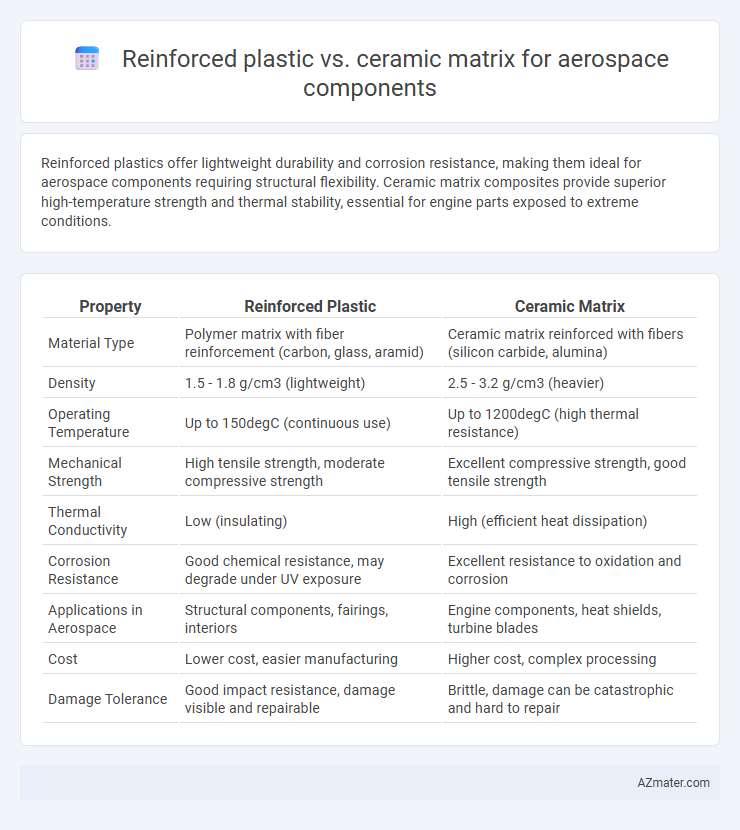Reinforced plastics offer lightweight durability and corrosion resistance, making them ideal for aerospace components requiring structural flexibility. Ceramic matrix composites provide superior high-temperature strength and thermal stability, essential for engine parts exposed to extreme conditions.
Table of Comparison
| Property | Reinforced Plastic | Ceramic Matrix |
|---|---|---|
| Material Type | Polymer matrix with fiber reinforcement (carbon, glass, aramid) | Ceramic matrix reinforced with fibers (silicon carbide, alumina) |
| Density | 1.5 - 1.8 g/cm3 (lightweight) | 2.5 - 3.2 g/cm3 (heavier) |
| Operating Temperature | Up to 150degC (continuous use) | Up to 1200degC (high thermal resistance) |
| Mechanical Strength | High tensile strength, moderate compressive strength | Excellent compressive strength, good tensile strength |
| Thermal Conductivity | Low (insulating) | High (efficient heat dissipation) |
| Corrosion Resistance | Good chemical resistance, may degrade under UV exposure | Excellent resistance to oxidation and corrosion |
| Applications in Aerospace | Structural components, fairings, interiors | Engine components, heat shields, turbine blades |
| Cost | Lower cost, easier manufacturing | Higher cost, complex processing |
| Damage Tolerance | Good impact resistance, damage visible and repairable | Brittle, damage can be catastrophic and hard to repair |
Introduction to Aerospace Material Selection
Reinforced plastics offer high strength-to-weight ratios and corrosion resistance, making them ideal for aerospace components requiring lightweight construction and durability. Ceramic matrix composites provide exceptional thermal stability and resistance to wear and oxidation, suitable for high-temperature environments such as turbine engines. Selecting aerospace materials involves balancing mechanical performance, thermal properties, and environmental resistance to optimize component lifespan and efficiency.
Overview of Reinforced Plastics
Reinforced plastics in aerospace components offer high strength-to-weight ratios and excellent corrosion resistance, making them ideal for weight-sensitive applications. These composites typically combine polymer matrices such as epoxy or polyester with reinforcing fibers like carbon, glass, or aramid, enhancing mechanical properties and fatigue performance. Their versatility and ease of fabrication contribute to widespread use in aircraft structures, interior panels, and secondary load-bearing parts.
Fundamentals of Ceramic Matrix Composites
Ceramic matrix composites (CMCs) offer superior thermal stability and fracture toughness compared to reinforced plastics, making them ideal for high-temperature aerospace applications. Fundamental to CMCs is their combination of brittle ceramic matrices with ductile fiber reinforcements, which enhances crack resistance and improves mechanical reliability. These composites withstand extreme environments such as turbine engines, outperforming polymer-based composites in weight-to-strength ratio and thermal endurance.
Mechanical Properties Comparison
Reinforced plastics exhibit high tensile strength and excellent impact resistance, making them lightweight yet durable for aerospace applications. Ceramic matrix composites offer superior high-temperature stability, stiffness, and wear resistance, essential for engine components exposed to extreme conditions. Mechanical performance balances include reinforced plastics providing more flexibility and toughness, whereas ceramic matrix materials excel in hardness and thermal endurance.
Weight and Density Considerations
Reinforced plastics in aerospace applications typically exhibit lower density values ranging from 1.2 to 1.6 g/cm3, enabling significant weight reduction compared to ceramic matrix composites, which usually have densities between 2.5 to 3.3 g/cm3. The lower weight of reinforced plastics contributes to enhanced fuel efficiency and payload capacity, while ceramics offer superior thermal resistance but at the cost of increased mass. Weight-critical aerospace components often prioritize reinforced plastics due to their optimal strength-to-weight ratios despite ceramics' advantages in high-temperature environments.
Thermal Resistance and Stability
Reinforced plastics offer moderate thermal resistance and stability, typically withstanding temperatures up to 150-200degC, which limits their use in high-temperature aerospace applications. Ceramic matrix composites excel in thermal resistance, maintaining structural integrity at temperatures above 1,200degC while providing superior thermal stability under cyclic thermal loads. The enhanced heat tolerance of ceramic matrices makes them ideal for engine components and thermal protection systems where extreme temperature environments are encountered.
Corrosion and Chemical Resistance
Reinforced plastics, commonly used in aerospace components, exhibit excellent corrosion resistance due to their polymer matrices, which are inherently inert to most chemicals and moisture. Ceramic matrix composites (CMCs) provide superior chemical resistance at high temperatures and resist oxidation and chemical degradation in aggressive environments, making them ideal for engine components and high-heat zones. Both materials enhance corrosion resistance compared to metals, but ceramics outperform reinforced plastics in extreme chemical and thermal conditions typical in aerospace applications.
Manufacturing and Processing Techniques
Reinforced plastics in aerospace components are predominantly fabricated using processes such as resin transfer molding (RTM) and automated fiber placement, enabling high strength-to-weight ratios with relatively low manufacturing costs and faster cycle times. Ceramic matrix composites (CMCs) require advanced techniques like chemical vapor infiltration (CVI) and slurry impregnation, offering superior thermal resistance and mechanical performance but involving longer processing times and higher production complexity. The choice between these materials hinges on balancing manufacturing scalability and performance requirements in aerospace applications.
Cost Analysis and Lifecycle Assessment
Reinforced plastics offer lower initial costs and reduced manufacturing complexity compared to ceramic matrix composites in aerospace applications, making them more cost-effective for short to medium lifecycle components. Ceramic matrix composites provide superior thermal resistance and durability, resulting in longer service life and lower maintenance costs, which can offset their higher upfront investment over extended use. Lifecycle assessments highlight reinforced plastics as suitable for budget-sensitive projects with moderate performance requirements, while ceramics excel in high-temperature, long-term aerospace environments, justifying their premium cost through enhanced lifespan and efficiency.
Applications and Future Trends in Aerospace
Reinforced plastics dominate aerospace applications requiring lightweight structures with high strength-to-weight ratios, such as fuselage panels and interior components, due to their excellent corrosion resistance and manufacturability. Ceramic matrix composites (CMCs) are increasingly utilized in high-temperature environments like turbine engine components and thermal protection systems, offering superior thermal stability and oxidation resistance. Future trends indicate a growing integration of hybrid composites and additive manufacturing techniques to enhance performance and reduce weight, supporting the aerospace industry's push for fuel efficiency and sustainability.

Infographic: Reinforced plastic vs Ceramic matrix for Aerospace component
 azmater.com
azmater.com